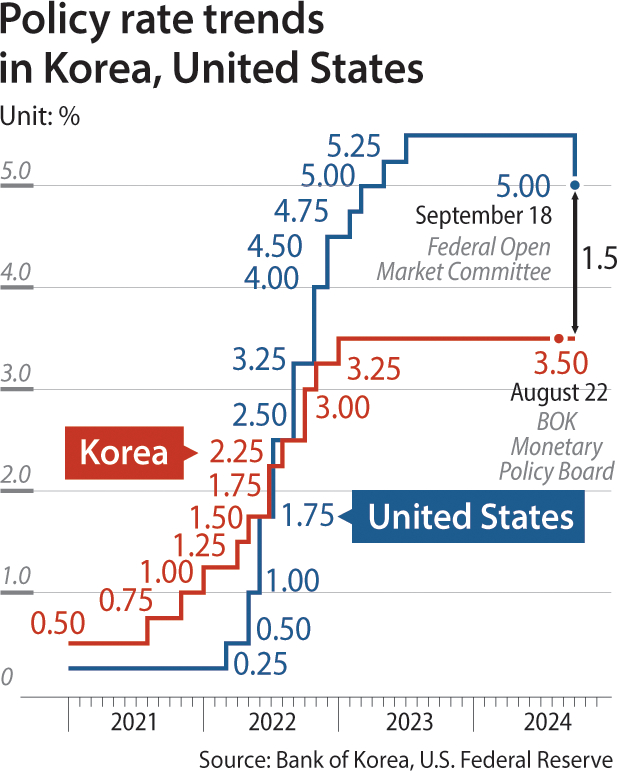As U.S. Fed slashes rate, expectations grow that Korea will follow suit next month
Published: 19 Sep. 2024, 18:03
Updated: 19 Sep. 2024, 18:49
-

- SHIN HA-NEE
- shin.hanee@joongang.co.kr
![U.S. Federal Reserve Chairman Jerome Powell walks from a news conference in Washington on Wednesday following the Federal Open Market Committee meeting. [AP/YONHAP]](https://koreajoongangdaily.joins.com/data/photo/2024/09/19/f2ac3150-65b3-4289-9e36-8355fde3b5a5.jpg)
U.S. Federal Reserve Chairman Jerome Powell walks from a news conference in Washington on Wednesday following the Federal Open Market Committee meeting. [AP/YONHAP]
Following the U.S. Federal Reserve's bold 0.5 percentage point rate cut, Korea is also moving toward a policy shift with expectations growing for an interest rate reduction in October.
“The U.S. monetary policy pivot is expected to have a positive impact on curbing the foreign exchange market volatility,” Bank of Korea (BOK) Senior Deputy Gov. Ryoo Sang-dai said during a market monitoring meeting at the central bank on Thursday.
“As such, this gives us more room to focus on the domestic economy, inflation and financial stability in maneuvering monetary policy in the future,” said Ryoo.
The U.S. Federal Open Market Committee decided to cut the federal funds rate by 0.5 percentage points, a larger reduction than the typical 0.25 percentage point adjustments, to a range of 4.75 percent to 5 percent range.

This is the first rate cut in the United States since 2020 and marks a policy shift after the Fed implemented its first rate hike in March 2022 during the surge of post-pandemic inflation.
The Korean central bank is mulling the timing to begin its rate-cut cycle, with yearly inflation slowing to the target of 2 percent in August. As the U.S. rate cut is expected to weaken the dollar against the local currency, this may further nudge the BOK toward a pivot.
However, the continued increase in household debt remains a challenge for the country as the growth in mortgage loans picked up pace in the second week of September despite the ongoing loan tightening.
As of Sept. 12, the outstanding mortgage loan balance at five major banks in Korea grew 2.1 trillion won ($1.6 billion) to 570.8 trillion won from the end of the previous month.
While the growth is milder than a record 8.9 trillion won surge in August, the weekly increase expanded in the second week, from a rise of 883.5 billion won in the Sept. 2-5 period to a 1.3 trillion won jump in the Sept. 6-12 period.
Finance Minister Choi Sang-mok projected that the mortgage growth would eventually subside this month, citing tighter loan regulations implemented in September.
![From left: Financial Services Commission Chairman Kim Byoung-hwan, Bank of Korea Gov. Rhee Chang-yong, Minister of Economy and Finance Choi Sang-mok, and Financial Supervisory Service Gov. Lee Bok-hyun attend a senior economic official meeting following the U.S. interest rate cut held in western Seoul on Thursday. [YONHAP]](https://koreajoongangdaily.joins.com/data/photo/2024/09/19/b7d50714-1de9-4713-9d3b-ea5a763faddc.jpg)
From left: Financial Services Commission Chairman Kim Byoung-hwan, Bank of Korea Gov. Rhee Chang-yong, Minister of Economy and Finance Choi Sang-mok, and Financial Supervisory Service Gov. Lee Bok-hyun attend a senior economic official meeting following the U.S. interest rate cut held in western Seoul on Thursday. [YONHAP]
"Although household debts, led by mortgage loans, increased as a rise in housing transactions has been reflected with a time lag, the growth is expected to slow down with policy measures taking visible effect starting September,” said the minister during a senior economic official meeting on Thursday.
The meeting, held in Seocho District, western Seoul, was attended by Korea's four economic policy chiefs along with Choi: BOK Gov. Rhee Chang-yong, Financial Services Commission Chairman Kim Byoung-hwan and Financial Supervisory Service Gov. Lee Bok-hyun.
During the meeting, Choi also addressed the slumping domestic demand. “Following the monetary policy pivot in the major economy, the government will accelerate its drive to boost domestic demand and stabilize livelihood,” he said.
The BOK’s Monetary Policy Board is set to hold two rate-setting meetings this year, one in October and the final in November. Analysts largely expect the BOK to make its first rate cut at the upcoming meeting on Oct. 11. Nevertheless, the household debt situation remains a significant uncertainty, as the central bank governor has repeatedly warned against further stimulating housing prices.
“Given the large rate cut by the U.S. Fed and the recent steep deceleration in household loan growth, it can be said that the BOK’s rate cut in October is now more certain,” said Kim Ji-man, a senior analyst at Samsung Securities.
“Regardless, considering that the Monetary Policy Board is wary of the financial stability situation, there are remaining uncertainties regarding the pace of rate cuts,” Kim noted, suggesting that the rate cut may be slower than the market expectation.
Ha Keon-hyeong, an economist at Shinhan Investment and Securities, also projected that “if the weekly mortgage loan growth slows down to 1 trillion won during the next three weeks leading up to the rate-setting meeting, a 0.25 percentage point is more likely to come in October.”
BY SHIN HA-NEE [shin.hanee@joongang.co.kr]










with the Korea JoongAng Daily
To write comments, please log in to one of the accounts.
Standards Board Policy (0/250자)